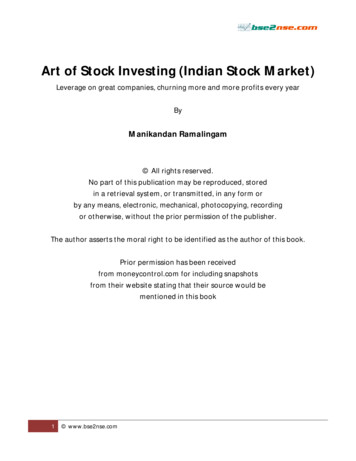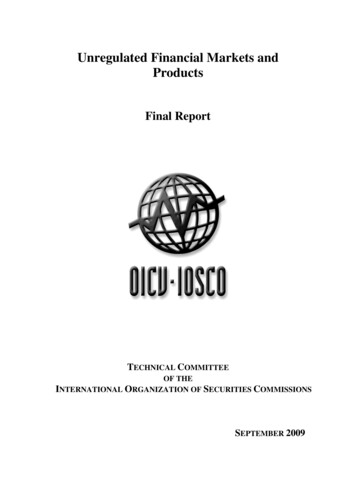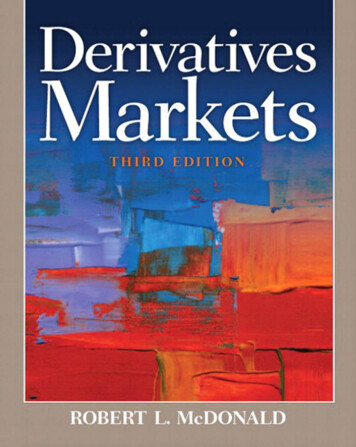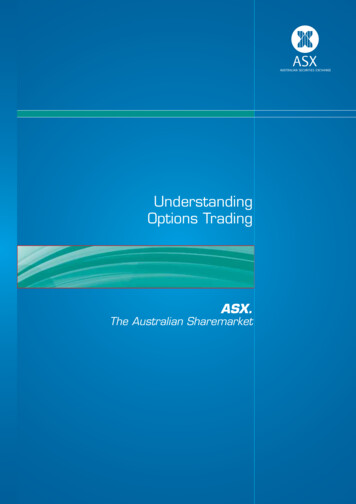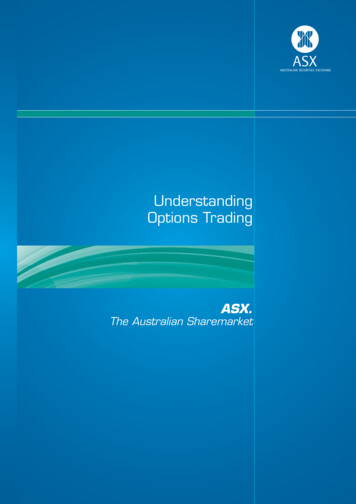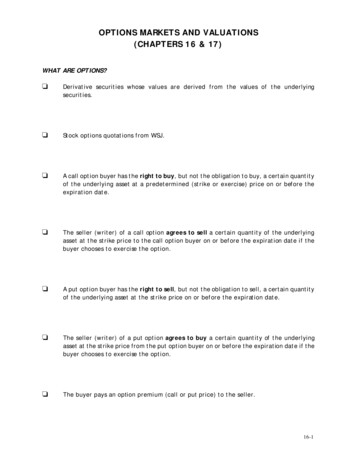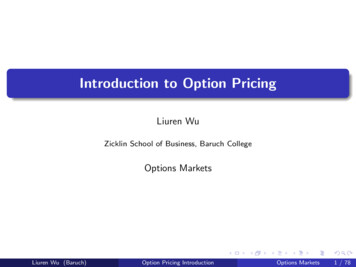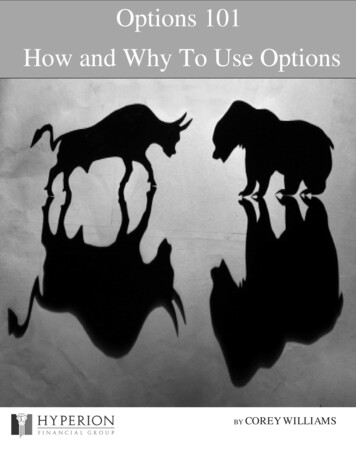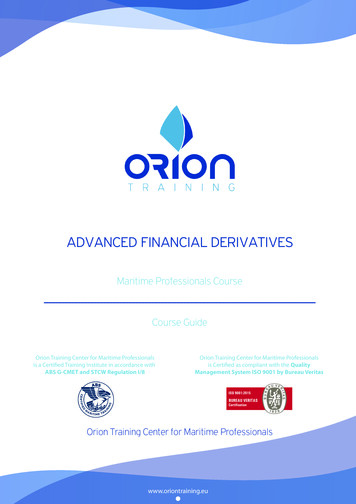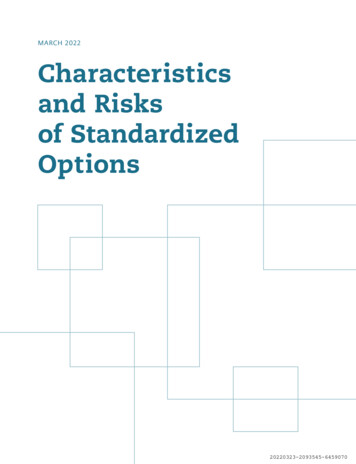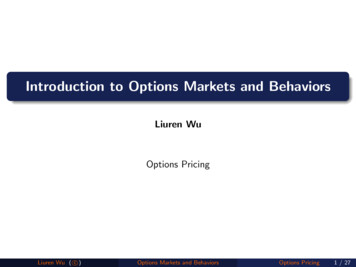
Transcription
Introduction to Options Markets and BehaviorsLiuren WuOptions PricingLiuren Wu ( c )Options Markets and BehaviorsOptions Pricing1 / 27
Definitions and terminologiesAn option gives the option holder the right/option, but no obligation, to buyor sell a security to the option writer/sellerfor a pre-specified price (the strike price, K )at (or up to) a given time in the future (the expiry date )An option has positive value.Comparison: a forward contract has zero value at inception.Option typesA call option gives the holder the right to buy a security. The payoff is(ST K ) when exercised at maturity.A put option gives the holder the right to sell a security. The payoff is(K ST ) when exercised at maturity.American options can be exercised at any time priory to expiry.European options can only be exercised at the expiry.Liuren Wu ( c )Options Markets and BehaviorsOptions Pricing2 / 27
More terminologiesMoneyness: the strike relative to the spot/forward levelAn option is said to be in-the-money if the option has positive value ifexercised right now:St K for call options and St K for put options.Sometimes it is also defined in terms of the forward price at the samematurity (in the money forward): Ft K for call and Ft K for putThe option has positive intrinsic value when in the money. Theintrinsic value is (St K ) for call, (K St ) for put.We can also define intrinsic value in terms of forward price.An option is said to be out-of-the-money when it has zero intrinsicvalue.St K for call options and St K for put options.Out-of-the-money forward: Ft K for call and Ft K for put.An option is said to be at-the-money spot (or forward) when the strikeis equal to the spot (or forward).Liuren Wu ( c )Options Markets and BehaviorsOptions Pricing3 / 27
More terminologiesThe value of an option is determined bythe current spot (or forward) price (St or Ft ),the strike price K ,the time to maturity τ T t,the option type (Call or put, American or European), andthe dynamics of the underlying security (e.g., how volatile the securityprice is).Out-of-the-money options do not have intrinsic value, but they have timevalue (value of optionality).Time value is determined by time to maturity of the option and thedynamics of the underlying security.Generically, we can decompose the value of each option into twocomponents:option value intrinsic value time value.Liuren Wu ( c )Options Markets and BehaviorsOptions Pricing4 / 27
Payoffs versus P&LsFor European options, the terminal payoff can be written as (ST K ) forcalls and (K ST ) for puts at expiry date T .Since options have positive value, one needs to pay an upfront price (optionprice) to possess an option.The P&L from the option investment is the difference between the terminalpayoff and the initial price you pay to obtain the option.Do not confuse the two.The textbook likes to talk about P&Ls, but I like to talk about payoffs —Different perspectives:P&Ls: If I buy/sell an option today, how much money I can makeunder different scenarios? What’s my return?Payoffs: If I desire a certain payoff structure in the future, what typesof options/positions I need to generate it?Liuren Wu ( c )Options Markets and BehaviorsOptions Pricing5 / 27
An example: Call option on a stock indexConsider a European call option on a stock index. The current index level (spotSt ) is 100. The option has a strike (K ) of 90 and a time to maturity (T t) of1 year. The option has a current value (ct ) of 14.Is this option in-the-money or out-of-the-money (wrt to spot)?What’s intrinsic value for this option? What’s its time value?If you hold this option, what’s your terminal payoff?What’s your terminal payoff and P&L if the index level reaches 100,90, or 80 at the expiry date T ?If you write this option and have sold it to the exchange, what does yourterminal payoff look like?What’s your terminal payoff and P&L if the index level reaches 100,90, or 80 at the expiry date T ?Liuren Wu ( c )Options Markets and BehaviorsOptions Pricing6 / 27
Payoffs and P&Ls from long/short a call option(St 100, K 90, ct 14)303020P&L from long a callPayoff from long a call20100 10 200 10 20708090100Spot at expiry, ST110 306012030302020P&L from short a callPayoff from short a call 306010100 10 20 3060708090100Spot at expiry, ST110120708090100Spot at expiry, ST110120100 10 20708090100Spot at expiry, ST110120 3060 Long a call pays off, (ST K ) , bets on index price going up.Shorting a call bets on index price going down.Liuren Wu ( c )Options Markets and BehaviorsOptions Pricing7 / 27
Another example: Put option on an exchange rateConsider a European put option on the dollar price of pound (GBPUSD). Thecurrent spot exchange rate (St ) is 1.6285 per pound. The option has a strike(K ) of 1.61 and a time to maturity (T t) of 1 year. The 1-year forward price(Ft,T ) is 1.61. The dollar continuously compounding interest rate at 1-yearmaturity (rd )is 5%. The option (pt ) is priced at 0.0489.From the above information, can you infer the continuously compoundinginterest rate at 1-year maturity on pound (rf )?Is this option in-the-money or out-of-the-money wrt to spot? What’s themoneyness in terms of forward?In terms of forward, what’s intrinsic value for this option? What’s its timevalue?If you hold this option, what’s your terminal payoff, if the dollar price ofpound reaches 1.41, 1.61. or 1.81 at the expiry date T ?Liuren Wu ( c )Options Markets and BehaviorsOptions Pricing8 / 27
Another example: Put option on an exchange rateReview the forward pricing formula: Ft,T St e (rd rf )(T t) .rf rd T 1 t ln(Ft,T /St ) .05 ln(1.61/1.6285)/1 6.14%.Recall covered interest rate parity: Annualized forward return( T 1 t ln(Ft,T /St )) on exchange rates equals interest rate differential(rd rf ) between the two currencies.Long a put option pays off, (K ST ) , and bets on the underlying currency(pound) depreciates.Shorting a put option bets on pound appreciates.How does it differ from betting using forwards?Liuren Wu ( c )Options Markets and BehaviorsOptions Pricing9 / 27
Payoffs and P&Ls from long/short a put option0.50.50.40.40.30.3P&L from long a putPayoff from long a put(St 1.6285, Ft,T 1.61, K 1.61, pt 0.0489)0.20.10 0.1 0.20.10 0.1 0.2 0.3 0.3 0.4 0.4 0.51 0.51.21.41.6Spot at expiry, ST1.8210.50.50.40.40.30.3P&L from short a putPayoff from short a put0.20.20.10 0.1 0.21.821.21.41.6Spot at expiry, ST1.820.10 0.1 0.2 0.3 0.4 0.411.41.6Spot at expiry, ST0.2 0.3 0.51.2 0.51.2Liuren Wu ( c )1.41.6Spot at expiry, ST1.821Options Markets and BehaviorsOptions Pricing10 / 27
1201511510101105510500100 5 595 10 1090 15 15 2080859095100105Spot at expiry, ST110115 208012085859095100105Spot at expiry, ST11011580801202020 801515 851010 905500 5 5 105 10 110 15 158590Liuren Wu ( c )95100105Spot at expiry, ST110115120 20809095100105Spot at expiry, ST11011512095100105Spot at expiry, ST110115120 100 10 208085 95PayoffPayoffPayoff2015Payoff20PayoffPayoffWhat derivative positions generate the following payoff? 115859095100105Spot at expiry, ST110115120Options Markets and Behaviors 120808590Options Pricing11 / 27
Option value behaviors: Notationc: European call option price. C — American call price.p: European put option price. P — American put price.S: stock price. Ft,T — time-t forward price with expiry T .K : strike price.Today: either time 0 or time t.T : expiry date (or maturity with t 0).σ: Volatility (annualized standard deviation) of stock return.r : continuously compounded riskfree rate with maturity T (same as option).D: present value of discrete dividends paid during option’s life.q: continuously compounded dividend yield during option’s life (for foreigninterest rate for currency options).Liuren Wu ( c )Options Markets and BehaviorsOptions Pricing12 / 27
Option variation with spot price2520T 0T 1mT 1yT 0T 1mT 1y1816Put option value, ptCall option value, ct20151051412108642080859095100105Spot price, St110115120080859095100105Spot price, St110115120Dependence on spot follows from payoff function (when time to maturity iszero).In examples given below, I use the following benchmark numbers:St 100; K 100; σ 20%; t 0; T 2/12; r 5%; q 3%.(unless otherwise specified)Liuren Wu ( c )Options Markets and BehaviorsOptions Pricing13 / 27
Option variation with strike price2520T 0T 1mT 1y16Put option value, ptCall option value, ct20T 0T 1mT 1y18151051412108642080859095100105Strike price, K110115120080859095100105Strike price, K110115120Dependence on strike follows from payoff function (when time to maturity iszero).Liuren Wu ( c )Options Markets and BehaviorsOptions Pricing14 / 27
European option variation with time to maturity3030K 80K 100K 120201510500K 80K 100K 12025Put option value, ptCall option value, ct2520151050.20.40.6Maturity, T0.81000.20.40.6Maturity, T0.81Normally increase, but can decline, esp. for far out of money options.American option value always increases with time, given the option toexercise early.ATM option value increases with (approximately) square root of time.Liuren Wu ( c )Options Markets and BehaviorsOptions Pricing15 / 27
Option variation with volatility4550K 80K 100K 1204040Put option value, ptCall option value, ct353025201510353025201510500K 80K 100K 1204550.20.40.6Volatility, σ0.81000.20.40.6Volatility, σ0.81ATM option value is almost linear in volatility (square root of time).Options market is mainly a market for volatility.Liuren Wu ( c )Options Markets and BehaviorsOptions Pricing16 / 27
Option variation with interest rates and dividend yields3025K 80K 100K 1202015100.020.040.06Interest rate, r0.080.020.040.06Interest rate, r0.080.10.080.125K 80K 100K 120K 80K 100K 12020Put option value, pt20Call option value, ct10000.1251510500155500K 80K 100K 12020Put option value, ptCall option value, ct251510500.020.040.06Dividend yield, q0.080.1 500.020.040.06Dividend yield, qIncreasing interest rate or reducing dividend yield increases the growth rate of thestock price.Liuren Wu ( c )Options Markets and BehaviorsOptions Pricing17 / 27
American v. European optionsThe above graphs are all generated for European options, based a simpleoption pricing model, which we’ll deal with later.An American option is worth at least as much as the correspondingEuropean option: C c and P p.The difference is due to the extra option you get from an Americanoption: You can exercise any time before the expiry date.Hence, the difference is also referred to as the early exercise premium.Pricing American options is a bit harder — we’ll need a numerical algorithmto deal with the early exercise premium.Liuren Wu ( c )Options Markets and BehaviorsOptions Pricing18 / 27
Obvious arbitrage opportunities on call optionsSuppose that ct 2, St 20, T t 1, K 17, r 5%, q 0.Is there an arbitrage opportunity?Suppose that ct 21, St 20, T t 1, K 1, r 5%, q 0.Is there an arbitrage opportunity?Liuren Wu ( c )Options Markets and BehaviorsOptions Pricing19 / 27
Bounds on a call optionLower bound:ct max[0, St e q(T t) Ke r (T t) ] max[0, e r (T t) (Ft,T K )].If the call price is negative, you are paid to own an option.If the call price is lower than the value of the forward at the samestrike, e r (T t) (Ft,T K ), buy the call and short the forward:Today’s value from the transaction is: ct e r (T t) (Ft,T K ) 0.At maturity, the payoff is (ST K ) (ST K ) (K ST ) 0.Point to remember: An option is worth more than a forward.Upper bound: ct St e q(T t) e r (T t) Ft,T .If violated, write the call and long a forward at zero strike.Today’s value from the transaction is: ct e r (T t) Ft,T 0.At maturity, the payoff is (ST K ) ST min(ST , K ) 0.A forward at zero strike is the same as a call at zero strike.A call with positive strike is worth less than a call with zero strike.More generally, c(K1 ) c(K2 ) for all K1 K2 . — Can you devise anarbitrage trading when this monotonicity condition is violated?In the presence of discrete dividends, the bounds are:[St D Ke r (T t) , St D].Liuren Wu ( c )Options Markets and BehaviorsOptions Pricing20 / 27
Less obvious arbitrage opportunities on call optionsSuppose that ct 3.2, St 20, T t 1, K 17, r 5%, q 3%.Is there an arbitrage opportunity?St e q(T t) Ke r (T t) 3.238.Suppose that ct 19.5, St 20, T t 1, K 1, r 5%, q 3%.Is there an arbitrage opportunity?St e q(T t) 19.41.Suppose that ct 19.5, St 20, T t 1, K 1, r 5%, D 1.Is there an arbitrage opportunity?St D 19.Liuren Wu ( c )Options Markets and BehaviorsOptions Pricing21 / 27
Bounds on a put optionLower bound:pt max[0, Ke r (T t) St e q(T t) ] max[0, e r (T t) (K Ft,T ).]If put price is negative, you are paid to own an option.If put price is lower than the value of the corresponding short forward,buy the put and long the forward:Today’s value from the transaction is: pt e r (T t) (Ft,T K ) 0.At maturity, the payoff is (K ST ) (ST K ) (ST K ) 0.An option to sell is worth more than a forward to sell.With discrete dividends, the lower bound is: Ke r (T t) St D.Upper bound: pt Ke r (T t) .If violated, write the put and save Ke r (T t) in the bank. Spend therest at water park.Today’s value: water slides.At maturity, the return from the bank is K . The worst possibleobligation from writing the put is K when the company goesbankruptcy (ST 0). So you make even in the worst case, makemoney otherwise. K (K ST ) min(ST , K ) 0.Monotonicity condition: p(K1 ) p(K2 ) for all K1 K2 .Liuren Wu ( c )Options Markets and BehaviorsOptions Pricing22 / 27
Arbitrage opportunities on put optionsSuppose that pt 2, St 20, T t 1, K 23, r 5%, q 3%.Is there an arbitrage opportunity?Ke r (T t) St e q(T t) 2.47.Suppose that pt 2, St 20, T t 1, K 23, r 5%, D 1.Is there an arbitrage opportunity?Ke r (T t) St D 2.88.Suppose the put price at 20 strike is 2 and at 21 strike is 1.9 at thesame maturity. Is there an arbitrage opportunity?Liuren Wu ( c )Options Markets and BehaviorsOptions Pricing23 / 27
Put-call parityRecall the put-call parity condition:The difference between a call and a put equals the forward.ct pt e r (T t) (Ft,T Kt ) St e q(T t) Kt e r (T t) St D Kt e r (T t)Suppose that ct 8, St 100, T t 1, K 100, r 0, q 0.Is there an arbitrage opportunity ifpt 7.pt 8.pt 9.Liuren Wu ( c )Options Markets and BehaviorsOptions Pricing24 / 27
Early exercise of American optionsUsually there is some chance that an American option will be exercised early.Exercise when the “exercise value” ((St K ) for call) is higher thanthe option value (Ct ).As a result, the American option is more expensive (valuable) than theEuropean option.An exception is an American call on a non-dividend paying stock, whichshould never be exercised early.Ct ct St Ke r (T t) St K exercise valueThe call option value for a non-dividend paying stock is always nolower than the exercise value.Liuren Wu ( c )Options Markets and BehaviorsOptions Pricing25 / 27
Cheat sheet: Summary of important relations/boundsForward pricing:Ft e (r q)(T t) St e r (T t) (St Dt ),European options bounds:ctpt [e r (T t) (Ft,T K ) , [e r (T t) (K Ft,T ) ,e r (T t) Ft,T ]e r (T t) K ]Put-call parity for European options:ct pt e r (T t) (Ft,T Kt ) e q(T t) St e r (T t) K .Put-call inequality for American options:St eSt D q(T t) K K Ct Pt St Ke r (T t) Ct Pt St Ke r (T t)Monotonicity for both European and American options:p(K1 ) p(K2 ), c(K1 ) c(K2 ),for allK1 K2 .Most important: Know how to trade against violations of these conditions.Liuren Wu ( c )Options Markets and BehaviorsOptions Pricing26 / 27
SummaryBasic terminologies: call, put, American, European, in-the-money,out-of-the-money, intrinsic value, time value.Basic mechanisms of options trading: market making, margins, exchanges,stock splits, .Inside-out knowledge on payoff structures of different positions (long/short)in different derivatives (call/put, forward, spot).Option behaviors: How does option value vary with strike, spot, volatility,and time.Option no-arbitrage bounds.Liuren Wu ( c )Options Markets and BehaviorsOptions Pricing27 / 27
Option variation with spot price 80 85 90 95 100 105 110 115 120 0 5 10 15 20 25 Call option value, c t Spot price, S t T 0 T 1m T 1y 80 85 90 95 100 105 110 115 120 0 2 4 6 8 10 12 14 16 18 20 Put option value, p Spot price, S t T 0 T 1m T 1y Dependence on spot follows from payo function (when time to maturity is zero).

